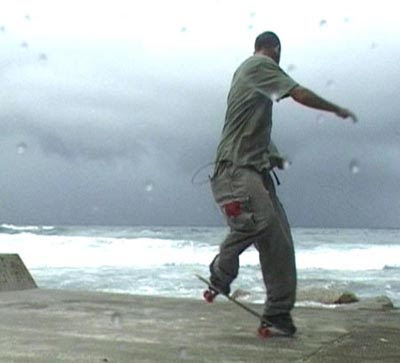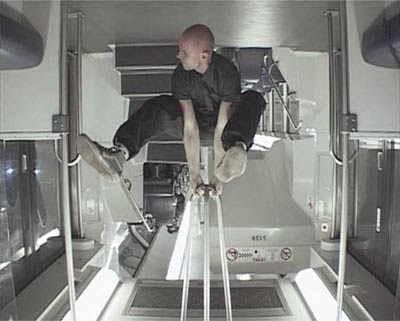A FIVE-minute DVD of a lone man skateboarding against an angry sky at Bondi Beach is the first digital video artwork to be auctioned in Australia.
The artwork, titled Storm Sequence, by Sydney artist Shaun Gladwell, was sold by Sotheby’s for the price of $84,000 when auctioned on August 27
Shaun Gladwell‘s work has always troubled me, trapping me somewhere between love and fear. It’s easy enough to understand people’s attraction to it – and the artist’s rapid rise to prominence in a scene that lusts for innovation and the imprimatur of cool – but for all its smooth edges and sleekly formed logic, there seems to be a marble rattling on the inside of the tank.
Which is not to say I don’t think the guy is a first-rate artist, he’s got some pretty good ideas, and they’re generally superbly executed, so what’s not to like? Think of Tanagara, the first of his works to come to my attention. He films himself hanging upside down from the centre bars of the Tanagara train’s passenger aisle. A simple idea, the conceit, lies in the fact that the camera is upside down, so in the video he seems to be floating magically weightless in the midst of this most suburban of situations. It is a lovely piece, sweetly filmed, mysterious, resonant. It takes a lot of energy to be troubled by it. And yet I’m up for it. What could drive me to this?

Shaun Gladwell, Storm Sequence, 2000. Digital video.
Videography: Techa Noble, Original Soundtrack: Kazumuchi Grime.
Courtesy Sherman Galleries
So much of what Gladwell does seems to flow naturally from what he is, a young man fully engaged with the bourgeois, fashion-conscious artistic fringe of his city. An attractive boy, well connected, doing what he loves and being well rewarded for it, both monetarily as well as socially and spiritually, no doubt as well. You’d need to have a strong resolve not to feel the odd twinge of jealousy. Just think of his stock in trade, skateboarding. Scores of young men are out there filming themselves tumbling down the steps of St Mary’s cathedral while wearing t-shirts that describe their outsider status, yet none of them have been able to create DVDs of their efforts that sell for nearly 100k that get exhibited at major international festivals of art, that are dissected with forensic intensity by people like myself. How did he manage to turn his simple, commonplace obsession with doing a series of perfect “Ollies” into highly regarded art?
The short answer to that is, “if I knew, I’d do it myself”. Which of course is where the jealousy comes in. The longer answer is as complicated as the very question of art. Indeed, it may centre around that dreary old chestnut “what is art?”. Heaven preserve us, Duchamp shot that one in the head seventy years ago. We don’t need any of that talk. But still, something worries me. And, to pose a rhetorical question – do you know what it is? Answer – Shaun Gladwell’s pants. Yes, indeed. His pants. Well at least in the work in question. And if you’ll allow me to describe my fixation, it may give you an insight into why I have difficulties with his project.
In one of the “scenes” from the video installation Storm Sequence, we see Shaun skateboarding in the rain at the north end of Bondi Beach. The footage is quiet, beautiful, textured and toned, with the movement slowed to reveal the balletic quality of Sean’s athleticism. The work is true to his oeuvre, with its “emphasis on the city (Sydney) as a stage for choreographed performances and interventions” that seeks to usurp “the strict rules (that) increasingly determine the use of public space / transport / art / architecture”. An admirable aim indeed, even though in practice it seems to mean something more along the lines of “I’ll skateboard where ever the fuck I want”. But the work, whilst absolutely delicious, was spoiled for me by one small, but rather telling detail. The first thing I noticed on a recent viewing was his pants. You see, he is wearing ultra baggy jeans as favoured by young sk8ters at the time he made the video. Now of course, as is the way with the extreme dialecticism of youthful fashion, such pants are considered deeply “uncool”. Hence my first thought on seeing the video was, “Shaun Gladwell is daggy”. That’s a bad reaction for many reasons. Not least of which being the idea that Sean’s work is strongly associated with the idea of “cool”. Skateboarding, performance, video, installations, all bleeding edge, all making claims to the “validity of now” that is at the centre of the cool aesthetic. But there is the rub. Only a few years later and your work has been “tagged” by time. You have become a period piece and people think about your clothes rather than your work.

Shaun Gladwell, Tangara, 2003.
Digital video. Videography: Gotaro Uematsu & David Griggs
Is this a problem? Well, no, except that one would hope that the power of the work would render such concerns mute within the overall grasp of it’s ambitions. And herein lies my concern, that all we have is surface, glistening and seemingly soulful, but heading quickly toward antiquity. His work becomes less a video contemplating the intersection of nature’s sublimity and the performative appropriation of the urban environment and more about the idea that “youth culture” is included within the gamut of contemporary art thereby each validating the other in a “circle jerk” of “cool”. In ten years time as skateboarding heads towards one of its periods of irrelevance the video will seem as quaint as if someone had decided to do yo-yo tricks in front of a gathering storm. Though I’m sure Duchamp would have considered such an idea as the very quintessence of art practice.
Yet despite such criticism he has a talent with video that renders simple ideas magical. Pataphysical man for instance is as transcendent as Tangara. Again (worryingly) he relies on the inversion of the camera, transforming a dancer doing the “old skool” B Boy trick of spinning on his head into a bizarre feat of gravity defying, ceiling high shenanigans. The trick this time lies in the mirrored surface upon which the work is performed. The reflection gives us both a sense of the original axis alongside the more pleasing inversion. Its all very sweet if a little dizzying and quite compulsive viewing, as far as contemporary video art goes. And this time there can be no damning him with accusations of cool hunting (though the B-Boy reference does nag). The work communicates effectively with a whole range of concepts, from Leonardo’s “vitruvian man”, to the notions surrounding pataphysics and others who have dealt with the subject such as Imants Tillers. And the performer’s clothes don’t attract undue notice. So if I’m going to damn it then how?
I suppose the difficulty I have lies in the gloss and glib ease of the work. Its energy inhabits the surface so completely that one doesn’t even bother to look for depths. You note the conceit, how elegantly it has been achieved and how gorgeous it looks and then you move on, assured that his aesthetic accords with your own and consequently the whole of the first world’s at this moment in time. Zeitgeist rules! But for how long? One can easily imagine such things turning up in parodic pastiches of the era in whatever the 2020’s version of Austin Powers will be.
So if we’re going to say no to skateboards because we fear for the future, what shall we say yes to? Are there ideas in contemporary video art that will be looked at as groundbreaking formulations that will go on to shape our appreciation, apprehension and understanding of what this relatively new medium will come to be? Or is video simply a momentary blip on the face of art soon to be overshadowed by interest in newer technological forms such as immersive, 3D and interactivity (blech). Well, I’m just a punter writing on an obscure bitchy Sydney blog, and I can feel your attention span being stretched even as I write this or to put it more properly – the limits of this forum don’t allow for a thorough examination of the topic so I’ll keep my comments to a few obvious instances.
We need to begin by saying that it’s a vexed question, since the relationship between technology and medium within video is more deeply felt than other media. Work that relies on technological innovation at the expense of concept, inspiration or idea is more likely to become judged on its dated technique than its artistic potency. In that regard its interesting to think of say a Susan Norrie next to a Patricia Piccinini. Which is not to say that either is less warranted in the contemporary milieu but it would seem that the elegiac beauty of Norrie’s images, redolent as they are with romantic sublimity are more likely to be revered as “art” in a few decades than Picinnini’s clever self referential plays on software derived images. Which is not to say that her work is unnecessary or irrelevant. Quite the contrary. Piccininni’s satiric conceptualisations play as much on the technology that creates them as the societal impulses upon which they comment. They are necessarily of their time. Yet it is their contemporaneity that makes you wonder how they will be received in decades to come.
Which brings us back to Shaun, his skateboarding and the Sotheby’s auction. If the market is investing so heavily in his work, will they be getting their money’s worth? Could I give a fuck? But if you’re the dude that fronted with the 80g, why not share and upload it to Youtube?
From Ian Houston. A major retrospective of Gladwell’s work In A Station of A Metro, opens this Thursday at Artspace.
